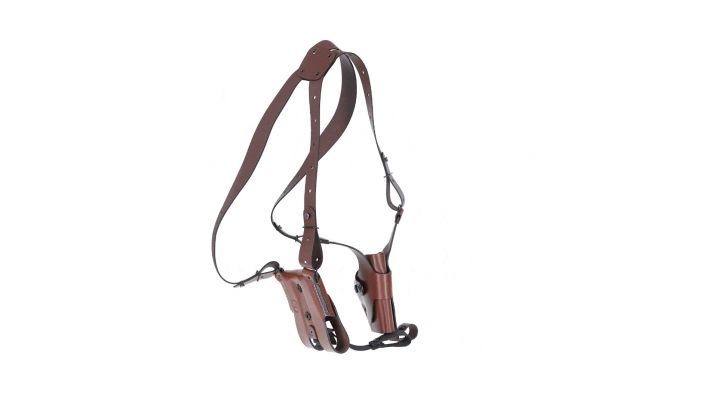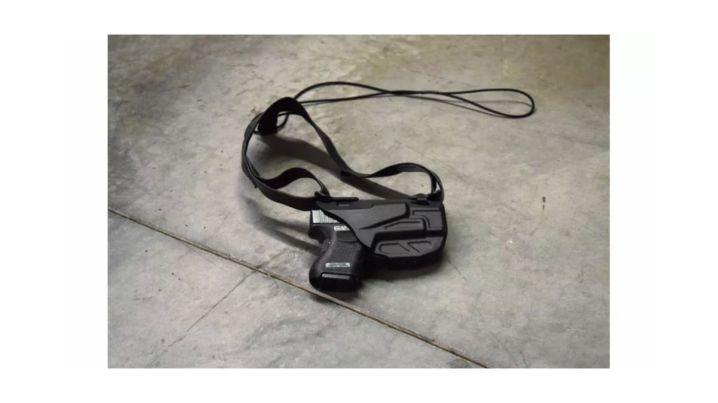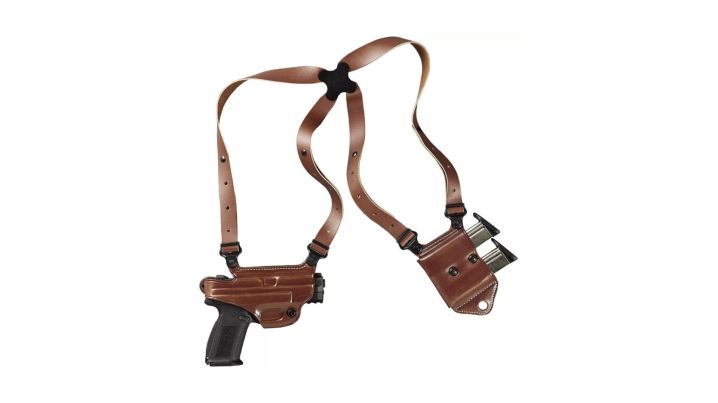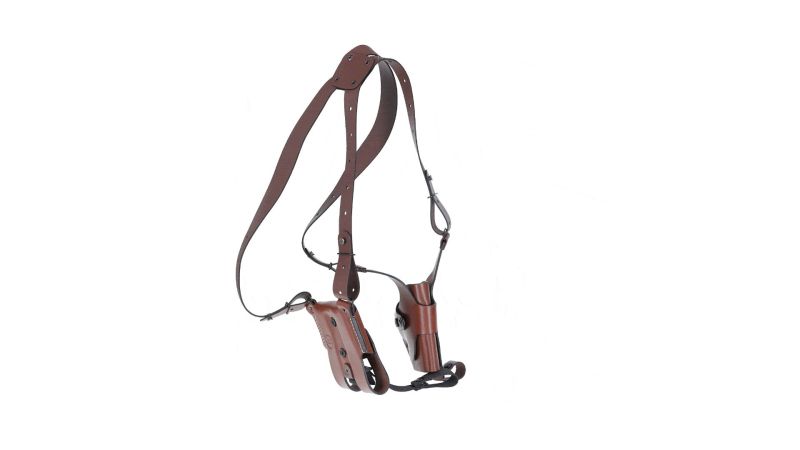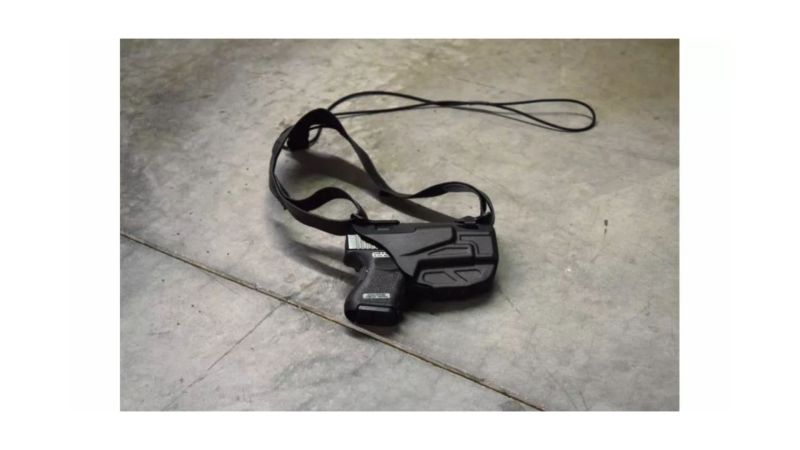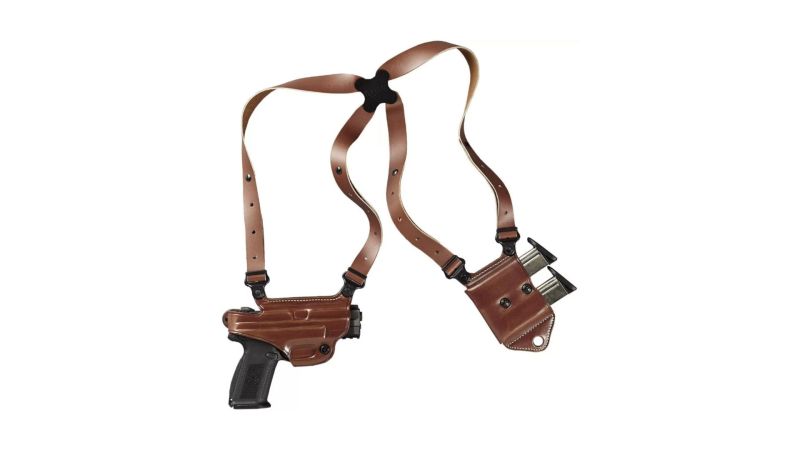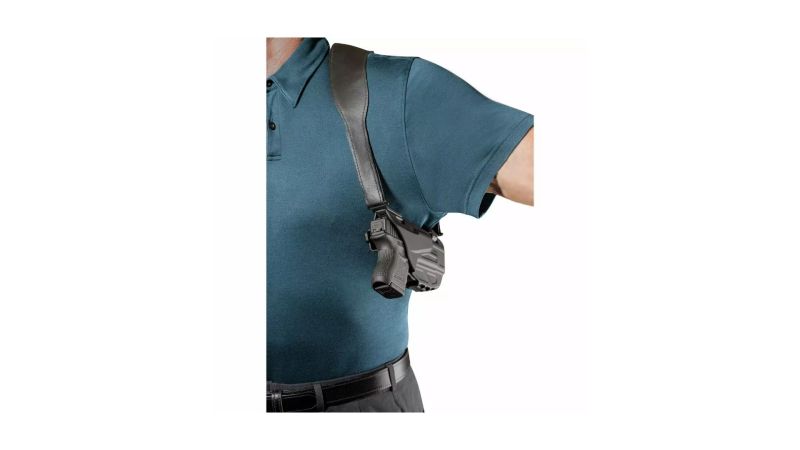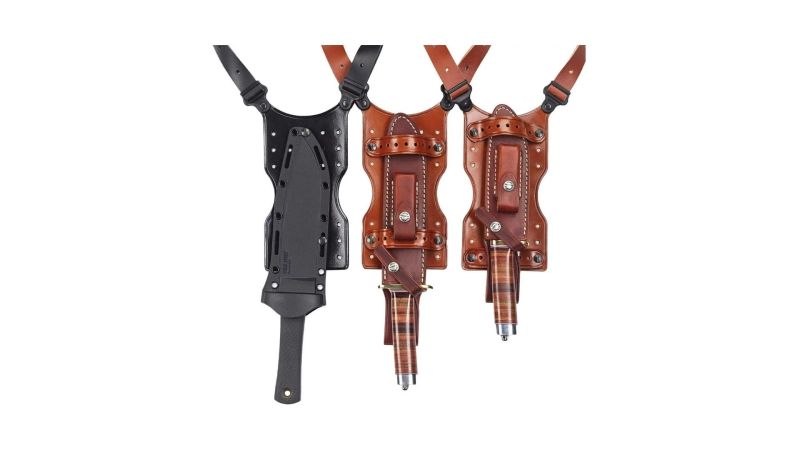We may earn revenue from the products available on this page and participate in affiliate programs.

We’ve all seen someone use a shoulder holster, but most of the time it’s on TV. It’s the preferred carry method of international spies, private investigators, and tough .44 magnum-toting cops. During my time in Afghanistan, shoulder holsters were also a badge of honor for SNCOs and officers with serious swagger. Most of the time, though, shoulder holsters get dismissed as a gimmick — and I’m not convinced that’s fair.
There are plenty of reasons shoulder holsters aren’t just for movie stars. They’re very practical for anyone who needs to carry while spending a lot of time behind a desk or in a vehicle. They do a great job of concealing full-size handguns. If nothing else, they look undeniably cool and feel great to draw from.
Having established that there are situations where shoulder holsters are warranted, we took it upon ourselves to bring you some of our favorites. Bring on the old-school leather, cutting-edge synthetics, and underarm accessories. It’s go-time.
Best Overall
Falco D603
Best Value
Safariland 7TS ALS Shoulder Holster
Editor’s Choice
Galco Miami Classic II
Best Synthetic
Safariland 7053 7TS ALS
Best Excessively Alpha
Galco SHUKA
Why should you trust us
Our staff includes a tremendous amount of shooting experience, and we’re always chatting with each other about gear we like and gear that’s let us down. The opinions can get pretty spicy, but the result is a very honest understanding of which items have earned our trust. We also work hard to get our hands on gear we haven’t used, so we can see how it performs in the real world. When in doubt, we spend hours researching specific products so you don’t have to. We have no problem spending all day reading about how various manufacturers treat their Kydex to resist heat deformation if it means you can cut straight to the good stuff.
Types of shoulder holsters
There are several styles of shoulder holsters, and each has its advantages and disadvantages. The obvious task is narrowing your search to options that are compatible with the weapon you plan to carry. Next, decide if you’re more likely to wear a shoulder holster for open or concealed carry. Finally, think about your body type and consider which option will be the most comfortable in real-world use.
Horizontal vs. vertical vs. angled shoulder holsters
The main difference that separates shoulder holsters from one another is the orientation of the holster itself.
Horizontal shoulder holsters are a long-time favorite because they work well for concealed carry. Keeping the barrel of your handgun parallel to the deck results in a smooth draw that’s relatively fast. Just remember that you can only conceal handguns with an overall length that’s smaller than the depth of your torso. Another drawback is flagging everyone behind you the whole time you’re carrying. This hasn’t stopped people from successfully using this method for decades, but it’s a consideration you need to know about. Expect to have a chat with the safety officer if you use this style of holster at the range.
Vertical shoulder holsters eliminate the flagging issue by pointing the muzzle down, and they also accommodate larger handguns. If you want to conceal a big wheel-gun like the ones people carry in bear country, this might be your only option. While vertical shoulder holsters are better than their horizontal counterparts in those aspects, they’re also slower to draw from.
Angled shoulder holsters strike a happy middle ground. Roto holsters that pivot once unlocked are popular because they allow you to carry your handgun vertically but draw it horizontally. This is all subject to personal preferences, but you can get a pretty solid understanding of which will work best for you by considering the advantages and disadvantages of each.
Leather vs. synthetic shoulder holsters
No self-respecting TV detective would be caught using anything other than a leather shoulder holster. Leather is still the most popular material for modern shoulder holsters and harnesses because it’s comfortable, firm, and can last a lifetime if you treat it right. Harnesses, in particular, tend to be leather because of the way it feels. Leather molds to your body over time to create a fit that’s second to none. That breaking-in process is critical when it comes to holsters because it means that the day you buy your holster is the tightest it will ever hold your firearm. Be patient and don’t overdo it. If you have any slop, the fit isn’t ideal. When properly formed, a leather holster will be very forgiving to your handgun’s finish and will provide a smooth, quiet draw.
Synthetic holsters are gaining in popularity because they don’t require a break-in period or maintenance. They’re also affordable to mass-produce with incredible consistency. Several of our staffers won’t use anything but a good Kydex holster. We chose reputable brands for this gear guide because not all Kydex products are built to the same standard. Never try to modify your holster to fit better, and — in the name of all that is holy — don’t try to make it fit a handgun it wasn’t designed for.
Nylon holsters and harnesses are available at very low prices — there’s a reason for that. They tend to be less durable and less comfortable, so we prefer to stick to leather and Kydex.
Key features of shoulder holsters
The features that separate good shoulder holsters from bad ones are the same you might consider for other styles of carry. In short, you need to consider what the holster is made of, how it sits on your body, and how it keeps your firearm secure while you’re on the go.
Holster
The holster itself is obviously the most important part of your setup. Fitment is key because you can’t afford to struggle with your handgun when it’s time to draw or holster it. As I mentioned, leather has traditionally been the most popular material for shoulder holsters. It works, it looks great, and people know what to expect. Besides, there’s a good chance that style is playing at least some role in your purchasing decision if you’re shopping for shoulder holsters, and leather just looks good.
Kydex shoulder holsters have been gaining in popularity because manufacturers can design a great-fitting holster and mass-produce it with incredible accuracy at relatively little cost compared to working with leather. Because of this, customization is much more affordable. If you run a weapon light, red dot, or suppressor-height sights on your pistol, your best bet is probably to find a Kydex holster that was built for that kind of setup.
Harness
The harness you choose will ultimately affect how eager you are to wear your shoulder holster. Bargain-basement rigs are tempting, but they’ll likely leave you sore and cranky in short order. Leather straps are the most comfortable and extra width can be helpful in distributing weight evenly. No matter which harness you choose, make sure it’s adjustable so you can fit it to your torso. When sized correctly, you should barely know it’s there.
Horizontal holsters often come on harnesses that look like a figure-eight and span your shoulder blades like a backpack. Vertical holsters, on the other hand, need to be worn low to create enough room to draw without hitting your weak-side arm. To prevent the holster from sticking to your handgun, they come with tie-downs that attach to your belt. These create a more rigid structure and allow a smooth draw.
Shoulder holster rigs may use metal or synthetic hardware. We found quality options with each, so that doesn’t need to be a deciding factor unless you have strong preferences one way or the other.
Security and retention
As with any holster, retention is key. Your weapon should come out when you draw it — period. Leather holsters typically have a retention strap that loops around the back of your slide or hammer. Before drawing, simply flick it loose with your draw-hand thumb. This may not be the fastest or most secure approach, but it’s worked for a long time and can be very effective if you train with it.
Kydex holsters are likely to use a paddle release just like you’d find on other styles of holsters. We like the Safariland approach of using a thumb paddle rather than one that puts your trigger finger over the trigger while drawing. Again, everyone has their own preference and the important thing is gaining proficiency with the gear you choose.
Accessories
Since shoulder holsters are rarely worn in kinetic environments, your odds of needing to reload in a hurry while wearing one are low. Still, magazine carriers are readily available and come with many higher-end shoulder holsters. This is convenient, but it also adds weight to your weak side that helps counterbalance the weight of your firearm on the other. Most can store two magazines, but I worked with a particularly awesome master sergeant in Afghanistan who carried four spare magazines. If you want to channel that kind of energy, be my guest. There are also carriers for individual rounds and speed loaders for you revolver aficionados.
If your style of carry is less Magnum PI and more Crocodile Dundee, you can also get sheathes that integrate into your shoulder holster’s harness. Is that necessary? Probably not. But who’s going to judge you (out loud and in person, anyway)?
Benefits of shoulder holsters
Critics of shoulder holsters have some valid points, but we have to give credit where it’s due; shoulder holsters do a few things very well. In the right environment and with the right handgun, a shoulder holster can be a fantastic choice.
Weight distribution
One of the biggest advantages shoulder holsters have is weight distribution. There’s a reason we carry gear in backpacks rather than pouches on our belt — it’s just more efficient. This doesn’t matter a whole lot if you have a compact or subcompact polymer gun, but a full-size, steel-framed pistol or revolver is definitely more comfortable in a shoulder holster than your average belt-mounted holster.
Spreading the load across your shoulder is great, but having all the weight on one side can still be uncomfortable and take a toll on your back over the course of a day. When we talked to Falco Holsters about building a setup, they took into account every aspect of the firearm I’d be using right down to the number of rounds in the magazine. That’s because they add a calibrated counterweight to the other side to make sure the harness is balanced. That level of service isn’t cheap, but it’s one of the things that makes high-end holsters a worthwhile investment.
Compatibility with larger handguns
We’ve all gotten a little spoiled by having access to a seemingly endless selection of pistols that are reliable, accurate, affordable, and easy to carry. Even full-size pistols can be slim enough to carry inside the waistband relatively easily. That isn’t always the case, though, and shoulder holsters can still be the best option for larger handguns.
Revolvers, in particular, can be difficult to carry (especially concealed) because of their width. Fitting one under your arm is a lot easier than letting it jut out from your waist. Think back to one of the most famous shoulder holster users of all time — if Clint Eastwood could conceal a massive .44 magnum on his thin frame, you can probably find a setup that works for you, too.
Accessibility
One of the biggest criticisms of shoulder holsters is that they’re not particularly easy to access. Reaching across your body and likely moving a cover garment out of the way isn’t as quick as many other styles of carry that place your firearm closer to your hand’s resting position. That’s true — until you sit down. If you spend a lot of time behind a desk or in a vehicle, carrying at the waist can be extremely uncomfortable and difficult to access. Even a drop holster on the thigh can be problematic, especially if your hands are elevated. Shoulder holsters offer a significant advantage in these situations because everything happens above the waist.
Shoulder holsters have also been favored by hunters and anglers who might be seated in a blind or standing in deep water most of the day. Keeping your sidearm high and dry is key, and a shoulder holster can be just the ticket.
Shoulder holster pricing
With a few exceptions, a good shoulder holster is going to cost more than $100. Our favorites generally range from $100 to $200 at the time of writing. By the time you add up quality components in the harness, holster, retention system, and hardware, it’s very difficult to achieve a two-digit price tag. Considering the personal attention offered by manufacturers like Falco Holsters, Safariland, and Galco, the prices we’ve seen are very fair.
The one exception on this list is our value pick from Safariland. In this case, the holster is outstanding (as we’d expect from Safariland). Cost is cut in the harness. That will result in a less comfortable overall package, but it is a way to save money without compromising on safety.
How we chose our top picks
If you’re in the market for a shoulder holster, you might be pickier than you would be for another style of carry. In addition to how the holster itself fits your handgun, you need to take into account how the rig fits your body. We looked for diverse options that can satisfy a range of needs. We looked for all-leather options, Kydex options, those with and without magazine storage, and even attachments for shoulder holsters. We included different styles of retention so you can find something that works with your draw. Unfortunately, there are a lot of shoddy products out there that shouldn’t be trusted with securing a firearm. We limited our picks to the manufacturers and systems we trust, so you can buy with confidence.
FAQs on shoulder holsters
You’ve got questions, Task & Purpose has answers.
Q: If shoulder holsters are so great, why are they so uncommon?
A: Shoulder holsters are an acquired taste. In most cases, they wouldn’t be the first option we recommend. Other styles of carry are just more efficient. There are circumstances, though, when a shoulder holster makes a lot of sense. If you’ve found yourself in one of those, we have you covered.
Q: Are shoulder holsters good for concealed carry?
A: Yes and no. Ultimately, you need to find what works for you. There are definitely times when shoulder holsters thrive, and others when they struggle. It all depends on what and where you’re carrying.
Q: Is there a shoulder holster that fits my [insert the very common pistol that you think is a special flower here]?
A: Probably. Holster manufacturers profit from catering to a wide consumer base, and materials like Kydex make adapting to different pistols more cost-effective than ever. If all else fails, universal options are out there.
